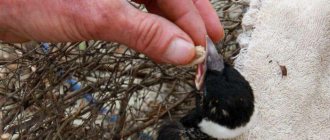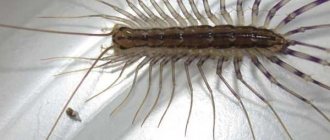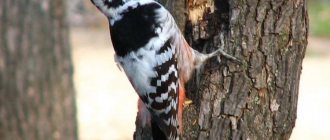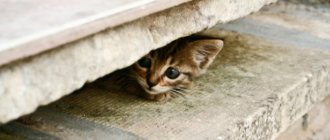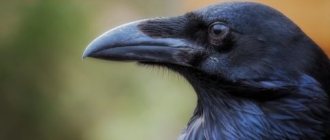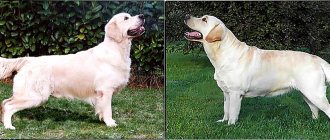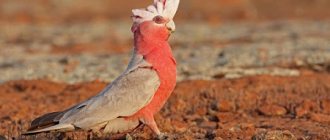Raven - description of the bird
The raven is the largest representative of the corvid family and the passerine order. This family includes the rook and the crow, the large-billed crow and the magpie, and others. Raven is similar to these birds. The plumage is black, the characteristic voice, which we call croaking. It is not surprising that these birds are often confused and called in one word - crow. Meanwhile, the raven has characteristic distinctive features.
Appearance
The body length of a raven is 60-70 cm; in males, the weight can reach 1500 grams. The female crow weighs a little less - about 800 grams. The beak is massive, curved, its upper part is larger than the lower. Under the beak there is a characteristic beard with protruding feathers. The plumage is black with a metallic sheen and a blue-violet tint. The wings are long, have a pointed shape, with a span of 140-150 cm. In flight, a raven can be identified by its wedge-shaped tail and soaring, similar to that of an eagle. It is precisely because of the shape of its wings that the crow flaps them more rarely compared to other members of its family.
What does a raven look like? Photo by: mgabor
Lifestyle and intelligence
The crow is rightfully considered one of the smartest animals. As a result of numerous experiments, ornithological scientists have come to the conclusion that the bird’s intelligence is on the same level as a four-year-old child. Thus, in one study, a bird was asked to retrieve a worm from a tall, narrow vessel of water. Pebbles and pieces of wood were placed next to the container. The raven quickly realized that the water level needed to be raised to get to the worm, and so he began throwing stones and pieces of wood into the vessel. Then he realized that the water rises higher only from the stones, and began to throw larger stones into the vessel, and then pulled out the pieces of wood so that they would not interfere with getting the worm. This experiment was repeated with other crows; the birds turned out to be just as smart.
In nature, a raven exhibits the same qualities and skills; it is just as smart and quickly navigates any situation. This feature is not innate in birds; it manifests itself in the process of observing its relatives.
Bird behavior during the breeding season
Crows are ready to start a family and have offspring by the second year of life. During mating games, which begin in February, crows circle with their “halves,” while demonstrating complex aerobatics to each other. Show themselves before mating. They remain faithful to their chosen partner for life. After mating, the birds build a nest together. A place for future chicks is selected as high as possible, in the crowns of separate trees and even on power lines. It is difficult for predators to reach the height; there is a good view, and this is a guarantee of safety.
External differences
In appearance, it is difficult to confuse the two species of these birds. A raven is a very large bird, up to 70 cm long; it is one and a half times larger than a crow. The crow has a more modest size - up to 56 cm long.
The plumage of birds also varies. The raven has pure black feathers, while the raven has black and gray feathers.
The shape of a raven's tail is wedge-shaped, while that of a crow is rounded.
The raven's crop has shaggy plumage, while the crow has no plumage there at all.
How long do crows live?
There is an opinion that crows are long-livers and live 100-300 years. According to some legends, these birds are completely immortal. In fact, the lifespan of a raven in the wild is approximately 10-15 years. In captivity, with good care, they can live much longer. In the Tower of London, ravens lived to be 40 years old. There are cases around the world where crows lived for 65 and 70 years under human care.
The average lifespan of a raven is 15 years. Photo by: katieb50
Features of behavior
The raven is considered a rare living creature. It is possible to meet a raven in any season. In winter, it appears near human homes, in garbage dumps. By nature, the raven is distrustful and prudent. He moves well on the ground. Before flying, the bird jumps several times. In captivity, they live from 15 to 70 years.
Crows do not live in the same territories every time. Some individuals fly away for the winter. In Turkmenistan, after the appearance of young animals, the number of flock members is 40-70 individuals; in the Caucasus in winter, flocks are smaller - 10-12 individuals. Birds migrate to distances of up to 200 km. During nesting, crows can fly impressive distances - to the shores of seas and rivers, to the foothills.
Birds form nests in forest areas, avoiding taiga areas. In treeless areas, rocks and coastal cliffs are developed. Nests are placed in trees: linden, oak, spruce, and in mountainous areas - at heights.
Crow and raven what is the difference
Raven and crow are different birds, although they belong to the same family of corvids. Not everyone knows how to distinguish a raven from a crow. They can be distinguished by external signs.
- The body size of a black or hooded crow is 46-52 cm. The weight is significantly less - from 400 to 750 grams.
- The beak is flatter, the plumage throughout the body is smooth, unlike the raven.
- Another feature is the blunt, rounded wings and fan-shaped tail.
Birds also differ in their voices. If the crow has a habitual and familiar croak, then the common raven makes sounds similar to “croo”. In addition, he can copy sounds, for example, the barking of a dog or the singing of another bird.
The large-billed crow is similar to the raven's beak, but it has a different color - black with a green tint.
Natural habitats
The crow lives in Scandinavia, Eastern Europe and even Asia. It is also common in Russia. The large-billed crow is found in the Far Eastern part of the country, in Primorye, on Sakhalin. The raven can be found in almost every corner of the Earth's Northern Hemisphere: on the Arctic coast, in the tundra, in the desert. At the same time, the raven settles in places remote from humans, more wild. But the crow is not afraid of people and lives quietly in the suburbs and cities.
Diet
Many people are interested in what crows eat, because it is widely believed that crows are scavengers because they feed on dead animals. This is not entirely true. Crows do eat dead animals, but they prefer fresh meat rather than rotten meat. In addition, crows are excellent hunters. They are not averse to eating lizards and frogs, small rodents and chicks of other birds.
Crows also do not refuse plant foods - fruits and grains, wild berries are also part of their diet. We can conclude that these birds are omnivores.
Raven eats meat. Photo by: Alexas_Fotos
Dimensions
The wingspan of a raven is quite large. He can use them to hook objects that are located at a distance of a meter from each wing. The dimensions of the bird itself are also impressive. Ravens can reach up to seventy centimeters in length. Not an eagle, but in some cases the difference between the two species of birds is not particularly critical. The hooded crow is smaller in size. Its wingspan does not exceed a meter, which is why they flap them more often. The length of the bird, as a rule, does not exceed forty to fifty centimeters.
Reproduction and offspring
The mating season for ravens is in February. Already in March, females lay from 2 to 6 eggs and incubate them for 20 days. Males also take part in this process, sitting on the eggs in turns. When the chicks hatch, mom and dad feed them together. The male feeds more often, because the female rarely leaves the nest and warms the chicks with her warmth. Young crows grow very quickly. Already at 10 days of age, the crow chick begins to learn to fly, and after about 30 days it flies. At three months of age, the crows reach the size of an adult bird. The offspring live with their parents for quite a long time; until approximately the next winter, the chicks do not leave the family nest. During this time they learn survival skills in the wild.
Nesting
Crows are considered to have reached sexual maturity at 2 years of age. Birds create unbreakable pairs. Nesting territories occupy 3-4 km, and sometimes up to 10. The locations do not change. If a nest has been destroyed, the raven forms another in the same area.
A couple usually creates two nests and uses them at different times. The nest has existed for several decades. Mating games and pair formation begin in early February or a little later, depending on the habitat.
The male and female build a new nest together. It is placed on the tops of different trees: oak, linden, aspen. The height at which the nest is located is usually 20 meters. If the bird is not disturbed, it can build nests near human habitation. Nesting structures are located on towers, temple belfries, and on the roofs of buildings.
The nest is constructed in the stem forks of trees. The nest itself is made of strong branches, and wool is used as flooring. Egg laying begins in mid-February. The further north the territory, the later the laying begins.
The number of eggs laid is 4-6, sometimes up to 7. The interval between clutches is 1-2 days. Egg size – 50x33 mm. Color – greenish-blue. Experts do not know for sure whether the female incubates the eggs alone or alternately with the male. Both parents provide food to the chicks. The chicks fly out in mid-May. After this, they live with their parents for a long time; mortality among young individuals is very high. Grown-up chicks leave adult birds only in the fall.
Signs and superstitions about ravens
The raven is often called the messenger of death. In the myths of different peoples, he acts as a guide to the world of the dead. In Scandinavia, ravens with the names Memory and Thought accompanied the god Odin. Having met them, the warrior already knew about his imminent death on the battlefield. In Slavic mythology, Nav was also a guide to the world of the dead. Maybe that's why we often see these birds in cemeteries.
Raven in the cemetery. Photo by: artemieixari
In the old days, hunters, when going hunting, were also afraid of meeting a raven, or even just hearing its cry. This meant bad luck. Therefore, hunters smeared the barrel of their guns with the blood of a raven in order to return with their prey.
Modern beliefs associated with the raven are no less alarming, associated with a warning of impending danger.
- If on the way you meet a raven sitting on stones, this promises a dangerous fellow traveler. We need to be more careful.
- If in nature a raven begins to circle over the chosen camp site, it is better to move to another place.
- If you met a raven sitting on a burnt tree, it means big trouble is nearby.
Natural enemies
The raven has plenty of enemies both in the air and on the ground. Among the birds there are other predators, just as large and strong - hawks and eagles. A serious danger comes from the nocturnal bird of prey - the eagle owl. He is able to sneak up on a crow's nest unnoticed and destroy it. The eagle owl's target is a crow cub, although the predator can even cripple an adult raven while everyone is sleeping.
Wolves, foxes, martens can also cope with a raven.
Population and species status
The greatest danger to the raven is humans. There were times when these birds were exterminated as pests that destroyed crops. So, in the 19th century, ravens were poisoned. This resulted in a sharp decline in the bird population. Over time, the situation changed; in many European countries, ravens were taken under protection, which led to an increase in their number. Now the number of birds is normal, but in some regions the population is not increasing due to difficult climatic conditions. Since in winter it is quite difficult for a bird to get food, the raven often settles next to a person, because where there are people, there is food.
Intelligence
Raven is a very smart bird. He is able not only to receive information, but also to evaluate it, analyze it, draw appropriate conclusions and apply it in practice. For example, if there is food in a glass filled with water, he will get it out by throwing other objects into the container. As a result, the food will rise to the top. In addition, the raven enjoys teaching its offspring and this has been proven experimentally. The crow has situational intelligence. She can make a simple tool for herself, but she will not share her own experience with anyone.
Attitude towards people
Despite the fact that the raven mainly lives in deserted places, when meeting a person it does not show fear. Rather, he watches the person, while not forgetting about his own safety. If a raven lives at home, it can show not only friendliness, but also jealousy. He loves and is friends only with his owner - the person who raised him or cured him, took care of the bird.
The crow behaves very boldly with people, and is not at all afraid. Thus, a large-billed crow can attack poultry or even a cat.
In cities where crows increasingly spend the winter, birds behave just as confidently towards humans.
Features of behavior
The crow is a pair-bonding bird. In winter, they can form flocks and occupy the nests of other birds. They often find their food in the same habitat as rooks and magpies.
The crow makes characteristic sounds. You can easily recognize this bird by its voice. Its voice has one timbre, the bird emits a cry “k-r-a-a”. Sitting on the top level of a tree, the crow is noisy because it caws many times without stopping, creating only short pauses.
Sometimes the croaking lasts for hours. At intervals the bird changes its location. The flapping of her wings is leisurely, there is no rush or fuss in her flight.
The carrion crow feeds on carrion, grains, insects, mammals and human food waste. In search of food, birds fly to human settlements. The crow finds food in garbage dumps near human houses. However, having found better products than ordinary garbage, he will prefer them. There are cases where city crows easily stole food from stores during unloading.
Keeping at home
The raven is an unusual pet, not like a cat or dog. He needs specific conditions of detention related to the characteristics of his life.
The raven is a large bird and needs space, so living in an apartment will be difficult. The bird needs a separate spacious enclosure where it can fly. It should be equipped with a drinking bowl, a feeding trough and a place for swimming. You need to walk your bird at least two hours a day.
It is important to know what crows eat at home. You can feed the bird almost anything. The diet should include meat, both raw and boiled, offal, cereals, fruits, eggs, you can give cheese and low-fat cottage cheese.
Raven eats meat. Photo by: Capri23auto
The raven needs to constantly pay attention, otherwise the bird will get bored and begin to destroy and break everything. Tattered wallpaper, broken glass, torn furniture - this is only a small part of what a raven, bored without its owner, can do.
Interesting Facts
Facts about ravens are very diverse and incredible. Crows steal for fun. They can watch another bird hide a treat in a secluded place, and then wait for the bird to fly away and hide its treasure in another place. And again they observe the bird’s reaction when it returns.
Crows cooperate with wolves. They lead wolves to the carcasses of dead animals, which they themselves cannot peck. The wolves chew the carcass, the crows eat the remaining meat.
The house raven does not tolerate other pets. If a raven lives in an apartment, its proximity to a cat or dog is unacceptable. In a fit of jealousy towards its owner, a raven can injure other pets.
Crows love to have fun. People have noticed that crows like to roll off roofs, and not just like that, but on a specially found device with a smooth surface.
The albino crow, although a rare phenomenon in nature, does occur. This is not a myth. Unusuality, accompanied by misunderstanding and alienation from society - this is what a black sheep means.
Location
Crows approach nesting very carefully. He chooses a place very carefully, and for two nests at once. One is built on a very high tree so that it is completely invisible, hidden from prying eyes. His second nest serves as a “dacha”. The bird uses nests alternately. The crow lives quietly in the city, and there are many “neighbors” around. Everything suits the bird and it feels comfortable here.
A huge freshwater reservoir under the sands of the Sahara: why the inhabitants of Africa do not use the gift of nature, watch the video:
Did you like the article? Then support us, click
:
Source
